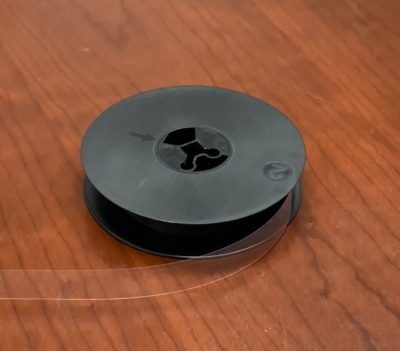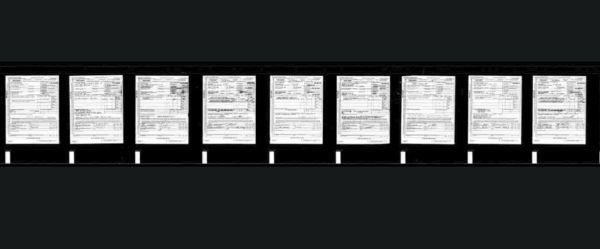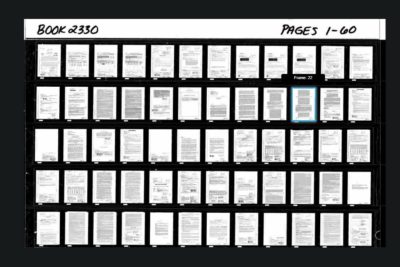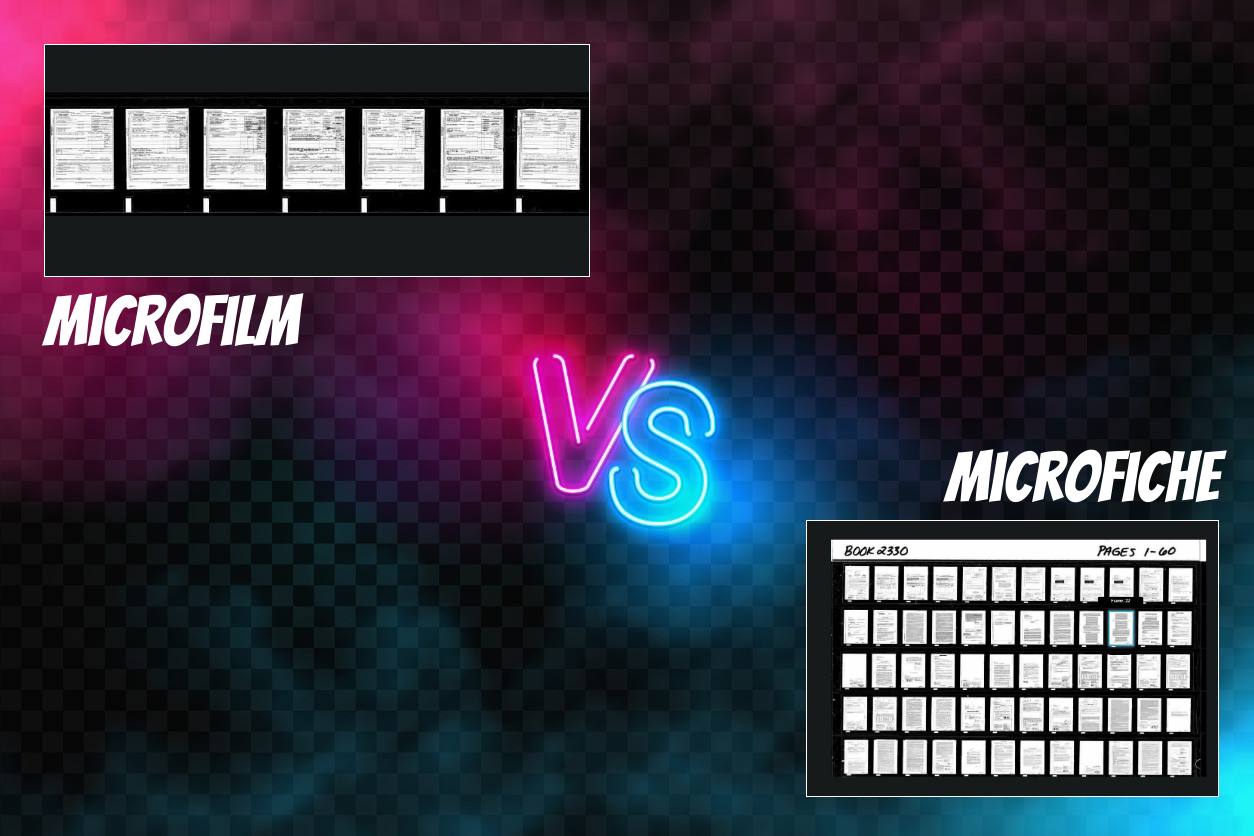Microfilm and microfiche are similar and different at the same time. It’s like siblings: sure, they come from the same family line and have things in common, but they’re distinct people. Knowing how to compare microfilm and microfiche can help you as you work with your records and decide what to do with them going forward. And if you work with us to digitize them, it’ll be critical for us to give you a quote.
In this brief overview, we’ll describe the basics of microfilm and microfiche, what makes them similar, what makes them different, and what you can do with them.
Don’t like reading? Watch the video below that dives into
microfilm vs. microfiche with extra bits not in the blog!
Microfilm vs. Microfiche: The Bottom Line
Microfilm is in roll (or reel) form; microfiche is in sheet (or card) form.
That’s the simplest way to differentiate the two.
What Is Microfilm?
Microfilm is a record-keeping medium that stores photographs/images of original hard copy records in a smaller format. In effect, you’re looking at a second-generation copy of a record in a way that allows you to store much more information in a smaller space. For example, a bankers box of files can hold about 2,500 pages, but it takes up a decent amount of room (it is a box, after all). That same 2,500 pages can be photographed and stored on a roll of microfilm, which is about 4×4”, smaller than a paperback book.
What does microfilm look like?
Microfilm looks like smaller versions of movie reels, and they’re even referred to as “reels” because of the spindle that the film is wrapped around. They kind of look like a fishing reel from the side, too. Another common term for microfilm is “roll film.”
The actual film part looks like a fruit rollup strip with a bunch of tiny images on it.

16mm microfilm reel

16mm microfilm strip of images
What is the purpose of microfilm?
Microfilm is used to retain records and data in a format that is easy to store, easy to access, and can last for a long time. In the second half of the 20th century, microfilm was created en masse because it was, at that time, the best method of storing and accessing loads of information. Instead of keeping warehouses full of paper and hard copy records, those documents were microfilmed.
What is microfilming of records?
“Microfilming” records specifically means creating microfilm from other images. Some agencies and organizations still require and use microfilm, so microfilm is still created to this day. “Microfilming” is different from “microfilm scanning,” which is scanning microfilm rolls and turning them into electronic records.
What kind of microfilm do I have?
Various types and versions of microfilm exist, including 16mm microfilm, 35mm microfilm, simplex, duplex, 100’, and 215’, as examples. If you’re not sure which kind you have, take a look at our page that describes the types of microfilm.
How much can you store on them?
On a standard 16mm, 100’, simplex roll of microfilm, you should be able to get up to about 2,500 images.
On other types of film you may only get about 800 or so, while on duplex 215’ film you could have almost 20,000 images!
What Is Microfiche?
Microfiche is like microfilm but comes on little sheets and has fewer images. There are a number of different types of microfiche, but the most common type (jacket fiche) can hold up to about 60 images.
On a microfiche sheet there’s a title strip that contains information related to the individual images. For example, if the fiche are from a registrar’s office and they’re of student records, the fiche will likely have the student name, maybe a graduation year or date of birth, and possibly a student number. The individual images on the fiche will be of grade reports, attendance information, and so on.
What does microfiche look like?
Microfiche looks like semi-transparent sheets and are a little bit bigger than index cards. The number of images on each fiche sheet will depend on the type of microfiche and on the amount of documents the record contains.

16mm jacket microfiche sheet
What is the purpose of microfiche?
Microfiche serves the same purpose as microfilm: it’s used to retain records and data in a format that is easy to store, easy to access, and can last for a long time. Though microfiche can’t store as much information on a single sheet as on a roll of microfilm, they can be somewhat easier to identify records because, in most cases, a single record will be on a single sheet of fiche. Like the student record example above, it’s oftentimes a 1-to-1 relationship, whereas a roll of student record microfilm could have 500+ student records on it.
What kind of microfiche do I have?
Microfiche comes in various types and formats, including “jacket fiche” (16mm microfiche and 35mm microfiche ) and COM microfiche, among others. If you’re not sure which kind you have, take a look at our page that describes the types of microfiche.
How much can you store on them?
The most common type of microfiche, 16mm jacket, you can store up to 60 images.
Another common type is COM microfiche, which normally holds around 270 images.
Knowing The Key Differences
Making your research simple is a priority, and highlighting the key differences between microfilm and microfiche will better help you understand which type you have and what you can do with it.
What is the difference between microfilm and microfiche?
- Microfilm is in a roll/reel format, like a roll of tape.
Microfiche is in a sheet/card format, like an index card. - Microfilm can hold thousands of images.
Microfiche can hold dozens or hundreds of images. - Microfilm is less expensive to scan, on an image-to-image basis.
Microfiche is more expensive to scan, on an image-to-image basis. - Microfilm rolls normally contain dozens or hundreds of individual records.
Microfiche sheets normally contain one record per sheet.
Knowing The Similarities
As with knowing the differences, knowing the similarities between microfilm and microfiche can be useful.
What’s similar between microfilm and microfiche?
- Storing microfilm and microfiche properly is the same: in dry, temperature- and humidity-controlled environments.
- Both microfilm and microfiche can last up to 500 years if handled and stored properly.
- Reading microfilm and microfiche can both be accomplished by using microfilm reader/printers. Also, they’re “eye-readable” and can be viewed without needing any special tools – a magnifying glass or a loupe will suffice, and even just looking closely can often work!
- Microfilm and microfiche can be scanned so you’re able to access and read them digitally.
Comparing Costs
We’ll focus on digitally scanning microfilm and microfiche, since that’s the overwhelming majority of what we do with these records.
On a per-unit basis, microfiche has a lower cost. You’re looking at anywhere from $0.75/sheet to $5/sheet, depending on which type of microfiche you have.
Microfilm generally ranges in the $20 – 40/roll range.
The big difference is the number of images that get scanned for that price. Remember that microfilm has from 1,000 images up to 20,000, depending on type. Microfiche has from 6 images up to 300, depending on the type. If you look at it that way, you’d need a good number of fiche to equate to a roll of film.
Because microfiche is broken down into smaller units (such as 60 images per sheet, for jacket microfiche), more handling and tracking is required; pricing is not linear in this case. On the whole, microfilm is more cost-effective to get scanned, but you have what you have. If you have a set of microfilm rolls and a set of microfiche sheets that are duplicated records, it’s more cost-effective to scan the microfilm rolls.
What Do I Do With My Microfilm & Microfiche?
The answer will be based on the goal you’re trying to achieve, so we’ll tackle a few ideas for you in brief.
Digitally scan your records
When you’re ready to move away from hard copies, you have the option of scanning your film and fiche into digital files. By scanning and creating a digital format, you’ll have the ability to search and access thousands, or even millions, of images and points of data in seconds and not have to worry about finding and filing physical material.
Knowing you want to scan your microfilm is one thing, and choosing the right scanning partner is another. Make sure you research multiple companies and ask the right questions to ensure they’re handling your data properly and that they’re the right fit for your needs.
Get a microfiche reader
If you decide to keep your hard copy microfilm rolls and microfiche sheets, you need a way to view the images on the records. To do that you can search for “microfiche readers” or “microfilm scanners” on the internet, and plenty of options will pop up. Some machines are better than others, and some are also newer. In general, one of the contemporary scanners that are digitally-enabled will run you $5,000+.
If you’re only interested in looking at images every once in awhile, you might do better to just get those specific records scanned, or go to a local library and use the microfilm machines there.
Store your microfilm
Do you almost never look at your data? You could have your records stored at a storage facility. Just keep in mind that microfilm and microfiche requires special storage arrangements, so do your research or else the material could get ruined.
Nothing
Yup, this is an option. Just keep the status quo and let it be!
Next Steps
Reach out to us today! Click the “Get Your Quote” button below, fill out the form, and we’ll quickly reply to you to discuss your project.
Further Reading
Read some additional articles about microfilm and microfiche:
“How Much Does Microfilm Scanning Cost?” covers the 9 factors that can affect the price you pay to digitize your film.
“How Much Does Microfiche Scanning Cost?” describes the factors that will influence your microfiche scanning project price.
“The BMI Microfilm Scanning Process” is our 10-step process to scan your microfilm. If you’re getting your film scanned, don’t you want to know how it’s done?

